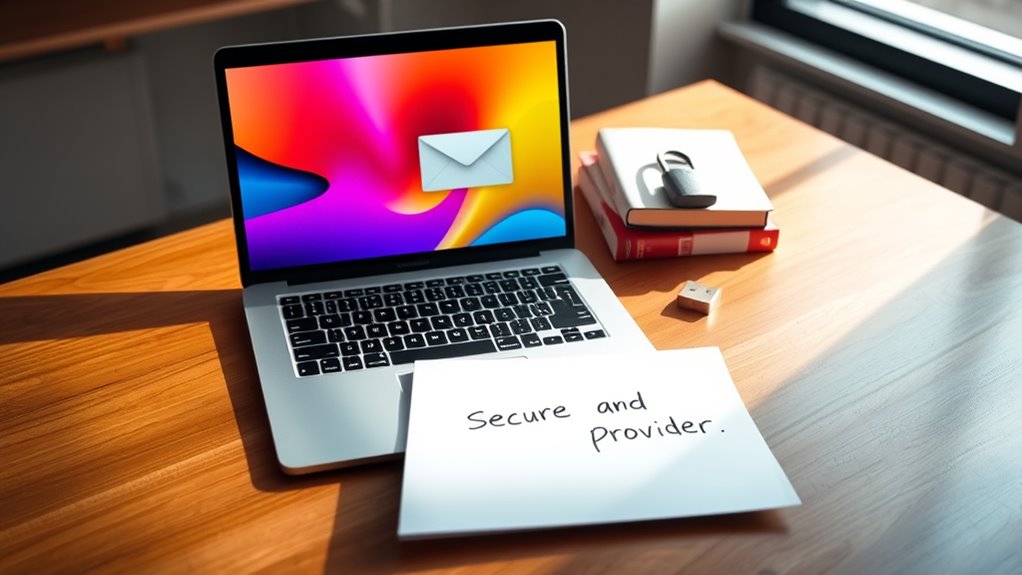When choosing a secure email provider, focus on end-to-end encryption to keep messages private from hackers and third parties. Look for providers that minimize metadata collection and have strong privacy policies. Features like two-factor authentication and open-source encryption boost security, while a user-friendly interface ensures easy access across devices. Check their reputation and commitment to ongoing security improvements. To find out more about how to select the best secure email service, continue exploring the key factors to contemplate.
Key Takeaways
- Ensure the provider offers end-to-end encryption to protect message content from third parties.
- Verify that the provider minimizes metadata collection to safeguard your activity privacy.
- Choose a reputable service with transparent privacy policies and strong security features like two-factor authentication.
- Opt for a user-friendly interface that supports seamless access across devices and reliable customer support.
- Consider the provider’s track record, security commitments, and independent reviews to ensure ongoing security and trustworthiness.

In today’s digital world, selecting a secure email provider is essential to protect your personal and professional information. With so many options available, understanding what features truly matter can be overwhelming. One critical aspect to consider is whether the provider offers end-to-end encryption. This technology ensures that your messages are encrypted from the moment you send them until they reach the recipient, making it nearly impossible for anyone else—whether hackers, advertisers, or even the email provider—to access your content. When choosing a secure email service, verify that it employs robust end-to-end encryption protocols, as this directly safeguards your message confidentiality.
Choose providers with end-to-end encryption to keep your emails private and secure from sender to recipient.
Another crucial factor is metadata privacy. Metadata includes details like sender and recipient email addresses, timestamps, and subject lines, which can reveal a surprising amount about your communications even if the message content is encrypted. A privacy-conscious provider minimizes the collection and sharing of metadata, giving you greater control over your information. Look for services that do not log or retain metadata unnecessarily or that offer features such as message anonymization or adjustable privacy settings. Protecting metadata privacy is essential because it prevents third parties from building detailed profiles based on your email activity.
Additionally, consider the provider’s stance on data collection and user privacy policies. Reputable secure email services prioritize user privacy and often operate under transparent policies that limit data retention and sharing. Some providers even offer open-source encryption protocols, allowing independent verification of their security measures. It’s also worth checking if the service provides features like two-factor authentication, which adds an extra layer of security to your account, making unauthorized access considerably more challenging.
Ease of use shouldn’t be overlooked. The most secure email provider isn’t helpful if it’s too complicated to use daily. Look for an intuitive interface, seamless integration with your devices, and reliable customer support. Compatibility across multiple platforms—web, desktop, and mobile—is essential, so you can access your email securely wherever you are.
Finally, assess the provider’s reputation and track record. User reviews, expert analyses, and the company’s history in handling security breaches can give you insight into their reliability. Choosing a provider that values security and privacy over mere convenience is essential to maintaining control over your communications. Prioritize services that openly publish their security practices and commit to ongoing improvements. Furthermore, implementing continuous learning models can help providers stay ahead of evolving cyber threats by adapting security measures in real-time.
Frequently Asked Questions
How Do I Verify an Email Provider’S Security Claims?
To verify an email provider’s security claims, start by checking if they use end-to-end encryption, which keeps your messages private. Look for transparency around security audits—they should regularly evaluate and publish their security practices. Research the provider’s reputation and user reviews, and confirm their compliance with industry standards like GDPR or ISO certifications. These steps ensure you’re trusting a provider that truly prioritizes your privacy and security.
Can I Use a Free Secure Email Service?
Think of free email services as a well-guarded castle with open gates—sometimes secure, sometimes not. Yes, you can use them, but you need to watch for their security features. Many free email providers offer encryption and spam filters, but they might not safeguard your privacy as robustly as paid options. Be cautious, read their security policies, and weigh whether their protections meet your needs before trusting them with sensitive information.
What Are the Best Practices for Secure Email Usage?
To use email securely, follow best practices like enabling end-to-end encryption to protect your messages and understanding encryption standards your provider uses. Be aware of data sovereignty, ensuring your data stays within your jurisdiction’s laws. Regularly update your software, use strong, unique passwords, and activate two-factor authentication. These steps help safeguard your privacy and guarantee your email communications remain confidential and compliant with security standards.
How Do I Migrate Emails Securely to a New Provider?
Imagine transferring your emails like moving valuable belongings—you want security at every step. To do this securely, use encryption protocols during migration to protect your data from interception. Before starting, review the new provider’s privacy policies to guarantee they prioritize your confidentiality. Always back up your emails, then use trusted migration tools or services, and verify the transfer’s integrity. This way, your information stays private and safe throughout the move.
What Are the Legal Implications of Choosing Certain Providers?
When considering providers, you need to think about legal compliance and data sovereignty. You could face legal issues if your provider doesn’t adhere to local laws or if your data isn’t stored within your country’s jurisdiction. Make sure you understand the legal implications of their data handling practices, including compliance with regulations like GDPR or CCPA. Choosing a provider that respects data sovereignty helps safeguard your legal standing and ensures your data is managed appropriately.
Conclusion
So, as luck would have it, choosing the right secure email provider isn’t just about features—it’s about peace of mind. When you pick a provider that values your privacy, you might find yourself enjoying a little more confidence in your digital life. Sometimes, the best choice happens when you stumble upon a service that feels just right, almost like it was made for you. After all, securing your email should be as effortless as a fortunate coincidence.









